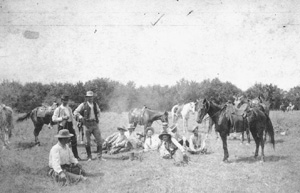TEXAS RANGERS

Texas Rangers, between 1890 and 1900
View largerThe Texas Rangers are the oldest state law enforcement agency in the United States. Throughout their storied history they have gone through several transformations and have performed an array of duties. A symbol of the American West and immortalized in film and print, the Texas Rangers have a worldwide reputation and are mentioned in the same breath with elite law enforcement agencies such as the Royal Canadian Mounted Police and Scotland Yard.
The origins of the Texas Rangers date back to 1823, when Stephen F. Austin appointed ten frontiersmen to defend the nascent Texas settlements from Indian attacks. These early ranger companies operated as loosely organized and irregular units until 1835, when a more permanent body was created. When the Texas Revolution broke out in 1836, the rangers served in a limited capacity as scouts, couriers, and escorts. Several rangers died defending the Alamo.
The Texas Rangers played an important role in defending the frontier under the Lone Star flag of the Republic of Texas. Under the leadership of Capt. John "Jack" Coffee Hays, the rangers became an experienced and feared fighting unit. Their effective use of the Colt revolver helped popularize the weapon. During the Mexican War (1846-48), Hays's rangers served as scouts, spies, and cavalrymen under generals Zachary Taylor and Winfield Scott. Mounted and heavily armed, the Texas Rangers earned a reputation as fiercely independent fighters. Because of their ruthless pursuit of Mexican guerrillas and their rough treatment of citizens, their Mexican counterparts labeled them "los diablos tejanos" (the Texas devils).
From the end of the Mexican War to 1874, the rangers saw little action. The U.S. Army guarded the Texas frontier, leaving the rangers with few responsibilities. They reappeared in 1874, when the state legislature created several ranger companies to deal with Indian attacks in West Texas, Mexican bandits along the Rio Grande, and the growing number of outlaws and desperadoes that infested Texas. In a military role, they assisted the U.S. Army in crushing Comanche and Kiowa resistance during the 1870s. As lawmen, the Texas Rangers traveled thousands of miles while tracking criminals. They gained fame by restoring peace in civil conflicts such as the Sutton-Taylor Feud and by capturing Great Plains outlaws such as gunfighter John Wesley Hardin and train robber Sam Bass.
With the end of the Indian wars and the general establishment of law and order, the duties and responsibilities of the rangers changed. In the 1910s and 1920s rangers guarded the Mexico- Texas border from Mexican revolutionaries, enforced prohibition laws, and policed oil boomtowns. In 1935 the Texas Rangers became a professional law enforcement unit when they were incorporated, along with the state highway patrol, into the newly created Texas Department of Public Safety (DPS). Since then they have been the investigative body of the dps. Modern-day rangers travel by car, plane, boat, helicopter, and only occasionally by horse. They still do not wear a uniform; the ranger badge is the only common accouterment worn by all rangers. Although their numbers remain small (only 106 rangers were on duty in 1997), the Texas Rangers continue to be the elite of Texas law enforcement.
Mark R. Ellis University of Nebraska at Kearney
Gillett, James B. Six Years with the Texas Rangers, 1875– 1881. New Haven CT: Yale University Press, 1925.
Samora, Julian, Joe Bernal, and Albert Peña. Gunpowder Justice: A Reassessment of the Texas Rangers. Notre Dame IN: University of Notre Dame Press, 1979.
Webb, Walter Prescott. The Texas Rangers: A Century of Frontier Defense. Austin: University of Texas Press, 1965.
Previous: Starkweather, Charles | Contents | Next: United States v. Sioux Nation of Indians
XML: egp.law.047.xml
